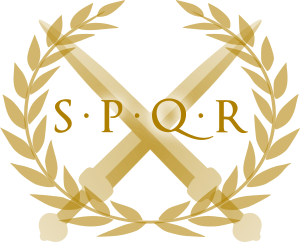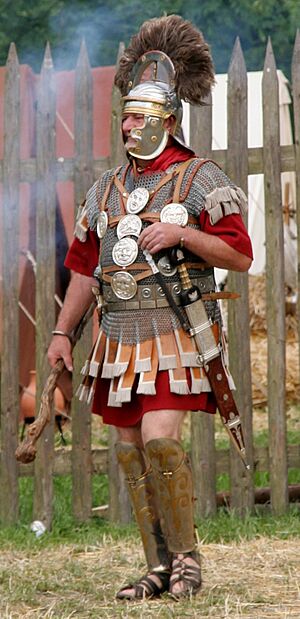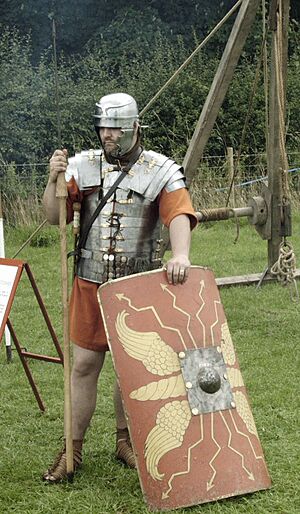Roman legion facts for kids
A Roman legion was a main part of the Roman army in ancient times. Think of it like a large army division today. When people said "the legions," they often meant the whole Roman army.
A legion usually had about 5,000 soldiers called legionaries. These were heavy infantry (foot soldiers) organized into groups called cohorts. Legions also had extra units called auxiliaries. These auxiliaries were not Roman citizens. They added cavalry (soldiers on horseback), archers, and skirmishers (light, fast fighters) to help the main legionaries.
The size of a legion changed over time. In the early Roman Republic, a legion had about 4,200 legionaries. Later, during the Roman Empire, a full legion had about 5,500 men. This included 10 cohorts, with the first cohort being larger than the others. Rome did not have a permanent army until around 107 BC. Before that, legions were formed for battles and then disbanded. During the early Roman Empire, there were usually 25 to 35 standing legions.
Contents
How Legions Were Organized
Early Roman Fighting Style
The first Roman legions were a lot like the Greek phalanx formation. Until the 4th century BC, armies fought in a tight phalanx. Roman soldiers looked similar to Greek hoplites. They stood in close rows, forming a shield wall with spears pointing forward.
The Republic Legion
During the Roman Republic, legions used three lines of soldiers in battle. Roman soldiers had to buy their own gear.
Legions in the middle Republic had these main groups:
- Equites (cavalry): These were horsemen, often wealthy young Romans. They showed off their skills, hoping for a political career. A legion of about 4,200 men had around 300 horsemen. They were divided into 10 groups of 30 men, led by decurions. Cavalry would attack enemy foot soldiers or fight other cavalry. Sometimes, they would even get off their horses to fight on foot.
- Velites (light infantry): These were poorer citizens who couldn't afford heavy armor. They were mainly skirmishers. They threw javelins to bother the enemy or to cover the movement of other troops.
- Heavy Infantry: This was the main part of the legion. These citizen soldiers bought their own equipment. They had an iron helmet, a shield, armor, and a pilum (a heavy javelin). After 387 BC, their main weapon was the gladius, a short sword. Their tough sandals could also be used in a fight. The heavy infantry was split into three lines based on experience:
- The hastati were new or less experienced soldiers.
- The principes were men in their prime, usually in their late twenties or early thirties.
- The triarii were the veteran soldiers. They were only used in very tough situations. They often rested on one knee when not fighting. The triarii had long hastae (spears) instead of the pilum and gladius. They fought in a phalanx formation. If the hastati and principes had to fall back, the sight of the strong triarii often stopped the enemy. The saying "to fall upon the triarii" meant to use your very last option.
Each of these three lines was divided into groups called maniples. Each maniple had two centuries of 60 men. A senior centurion led each century. A mid-Republic legion had about 4,500 men. Later, centuries had 80 soldiers. Each century had its own flag and was made of ten groups of eight soldiers. These eight men shared a tent, a grinding stone, a mule, and a cooking pot.
Legions and Roman Politics
During the Late Roman Republic, legions became very important in politics. Leaders could use their legions to gain power. Roman governors were not allowed to leave their provinces with their legions. When Julius Caesar crossed the Rubicon river into Italy with his legions, it caused a big crisis. This led to civil wars and the end of the Republic. The Roman Empire began under Augustus in 27 BC.
The Early Empire Legion
During the time of the Pax Romana (Roman Peace), a legion had 5,120 legionaries. It also had a similar number of auxiliary troops. This meant a legion commander could have 11,000 or more soldiers. More important legions were placed on dangerous borders or in difficult provinces. Some legions might have grown to 15,000–16,000 soldiers, similar to a modern army division.
A legate commanded the legion. This was usually a senator around 30 years old, serving for three years. Below him were six military tribunes. Five were staff officers, and one was a noble aiming for the Senate. There were also officers for medical staff, engineers, record-keepers, and other specialists.
Later Roman Legions
The legion system continued even after the Western Roman Empire fell. It was used in the Eastern Roman Empire until about the 7th century. The Byzantine armies kept the discipline and organization of the earlier Roman legions.
Centurions: The Backbone of the Legion
Centurions were key to the Roman legion. They were full-time professional officers. A basic centurion usually commanded 83 men, not 100. They moved up in rank by leading more important centuries.
The best centurions became Primi Ordines in the First Cohort. They commanded one of its ten centuries and also had staff jobs. The most senior centurion in a legion was the Primus Pilus. Only eight officers in a full legion were higher in rank than him:
- Five tribunes
- The Camp Prefect
- The Senior Tribune (second-in-command)
- The Legate (commander)
Related pages
Images for kids
-
The Roman empire under Hadrian (ruled 117–38), showing the legions deployed in 125
See also
 In Spanish: Legión romana para niños
In Spanish: Legión romana para niños












